
Courses, Conferences & Tools
Applications in Neurodevelopment: MNRI®: A Natural Approach to Gaining Range of Motion, Joint Stability and Muscle Tone Regulation for Individuals with Cerebral Palsy. Exploring Contemporary Methods.
Applications in Neurodevelopment: MNRI®: A Natural Approach to Gaining Range of Motion, Joint Stability and Muscle Tone Regulation for Individuals with Cerebral Palsy. Exploring Contemporary Methods.
Cerebral palsy is the most common cause of physical disability in childhood, with an estimated prevalence of 2.3 per 1,000 live births.
Learning to move functionally is a challenge for individuals diagnosed with cerebral palsy. Functional limitations in flexibility and range of motion inhibit the ability to move throughout all planes in space, impairing movement patterns needed for locomotion and performance of daily activities. These functional limitations are further compounded by joint instability and muscle tone dysregulation.
In this second lecture of our series on cerebral palsy, we discuss types of joints, joint range of motion, joint stability, and muscle tone regulation as they relates to an individual with cerebral palsy. We also explore the three movement planes and how lack of movement within each plane or in a combination of planes affects both basic and transitional motor skills. Traditional medical methods of addressing these limitations will be presented, followed by a discussion and demonstration of selected MNRI® techniques that can naturally improve impaired motor skills and function. The lecture concludes with a Q&A.
Lecturers:
Laurie Longest, MS, PT, MNRI® Instructor and Core Specialist
Diane Whiteside, PT, MNRI® Instructor and Core Specialist
Video Runtime: 2 hours, 56 minutes, 42 seconds.




